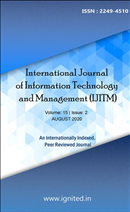A Review of Mediatation Enhancing the Emotional Intelligence and Subjective Well-being
Main Article Content
Authors
Abstract
Meditation is a type of mental exercise that aims to increase a person's capacity for selfawareness.A new state of awareness is induced, resulting in positive outcomes for all of humanity.Focusing on a single point, such as the breath, body, or mantra, is possible. People use it for everythingfrom pain relief to stress relief to enhanced mental clarity. Having an optimistic outlook on life is a goodthing. Only pleasure is objective in this situation. Whereas the term subjective well-being (SWB) is usedto describe how people evaluate their own sense of well-being in light of their feelings and thoughts.People's well-being depends on their level of happiness and enjoyment, as well as how they interact withthe rest of the human population. Emotional intelligence subjective well-being are therefore clearlyintertwined.
Downloads
Download data is not yet available.
Article Details
Section
Articles
References
- Beauchemin, J., Hutchins, T. L., & Patterson, F. (2008). Mindfulness Meditation May essen Anxiety, Promote Social Skills, and Improve Academic Performance Among Adolescents Witt Learning Disabilities. Complementary health practice review, 34-45.
- Cahn, B. R., & Polich, J. (2006). Meditation states and traits: EEG, ERP, and neuroimaging studies. Psychological bulletin, 132, 180-211. 152
- Chambers, R., Gullone, E., & Allen N. B. (2009). Mindful emotion regulation: an integrative review. Clinical Psychology Review, 29(6), 560-572.
- Chkhikvishvili, T. S., & Somunjan, A. (1996). The role of disbalance between “natural school” and informational overloading in genesis of stress reactions. International Journal of Stress Management, 173-178.
- Cohen, S. B.(2002). Happiness and the immune system. Positive Health, 9-12.
- College, A. (1998). Correlates, Causes, Effects, and Treatment of Test Anxiety. Review of Educational Research, 47-77
- Delmonte, M. (1984). Physiological Responses During Meditation and Rest. Biofeedback and Self-Regulation, 181-200.
- Fergusson, L. C., Bonshek, A. J., Boudigues, J. M. (1995). Personality and Health Characteristcs of Cambodian Ungraduates: A Case Study for Students Development. Journal of Instructional Psychological, 308.
- Feuerstein, G., & Payne, L. (2006). YOGA FOR DUMMIES. Delhi: Wiley India. Fontana, D., & Slack, I. (2012). Teaching meditation to children: The practical guide to the use and benefits of meditation techniques. Watkins Media Limited.
- GREENE JR, W. A. (1956). Process in psychosomatic disorders. Psychosomatic Medicine, 150-158.
- Hussain, D., Bhushan, B. (2010). Psychology of Meditation and Health: Present Status and Future Directions. International Journal of psychology and psychological Therapy, 439-451.
- Kabat-Zin, J. (2015). Meditation-it’s what you think. Mindfulness 6(2), 393-395.
- Miller, J., Fletcher, K., & Kabat-Zinn, J. (1995). Three-year fellow-up and clinical implications of a mindfulness meditation-based stress reduction in the treatment of anxiety disorders. General Hospital Psychiatry, 192-200.
- Goldin, P., & Gross, J. (2010). Effects of mindfulness-based stress reduction (MBSR) on emotion regulation in social anxiety disorder. Emotion ,83-92.
- Zeidan, F., Johnson, S. K., Diamond, B. J., David, Z., & Goolkasian, P. (2010). Mindfulness meditation improves cognition: Evidence of brief mental training. Consciousness and cognition, 19(2), 597-605.
- Lama, D., & Cutler, H. C. (1998). The Art of Happiness. London: Easton Press.
- Majumdar, M., Grossman, P., Dietz-Waschkowski, B., Kersig, S., & Walach, H. (2002). Does mindfulness meditation contribute to health? Outcome evaluation of German sample. The journal of alternative and complementary medicine, 8 (6), 719-730.
- Michaels R. R., Parra J., McCann D. S., Vander A. J. (1979). Renin, cortisol and aldosterone during transcendental meditation. Psychosomatic Medicine.
- Raffone, A., & Srinivasan, N. (2010). The exploration of meditation in the neuroscience of attention and consciousness. Cognitive Processing, 11(1), P. 1-7.
- Tang Y., Holzel B. K., Posner M. I. (2015). The neuroscience of mindfulness meditation. Nat. Rev. Neurosci. 16, p. 213-225.
- Veenhoven, R. (2013). CONDITIONS OF HAPPINESS. Springer Science & Business Media.
- Wallace, R. K., Silver, J., Mills, P. J., Dillbeck, M. C., Wagoner, D. E. (1983). Systolic Blood Pressure and Long-term Practice of the Transcendental Meditation and TM-Sidhi Program: Effects of TM on Systolic Blood Pressure. Psychosomatic Medicine, 41-46.

